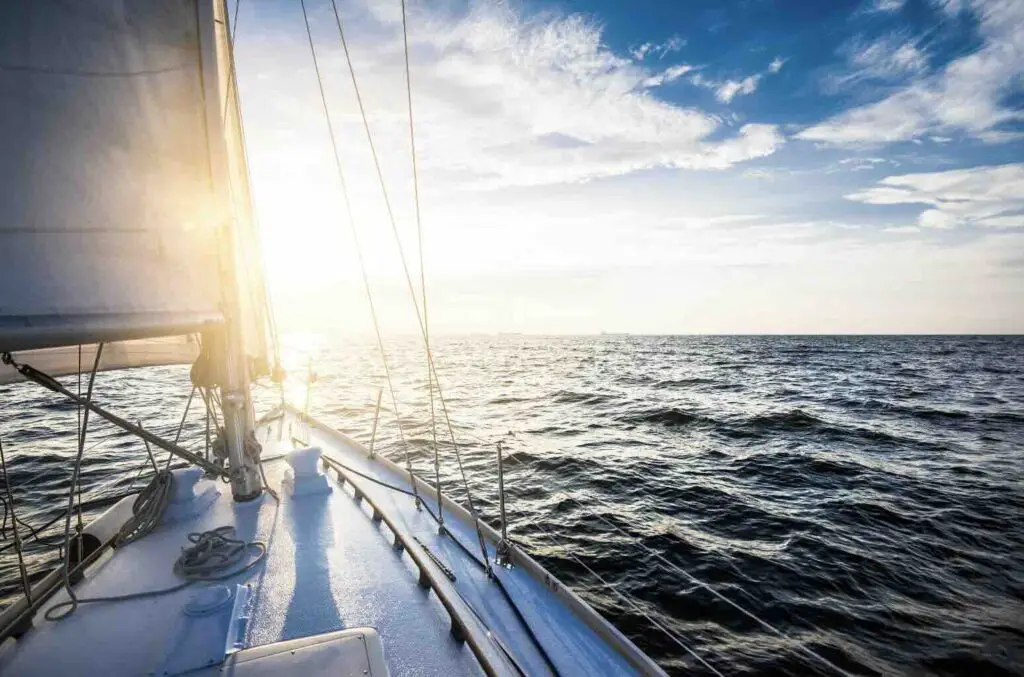Embarking on the world of sailing, you’re not just navigating the waters but also learning a new language essential for any mariner. Port, starboard, bow, and stern – these aren’t just directional cues but fundamental nautical terms that provide clarity, safety, and tradition in the rich tapestry of maritime culture.
As the bow slices through the waves towards the horizon, understanding these terms becomes as vital as the wind propels your sail vessel forward. With port and starboard distinguishing the left from the right sides of the boat when facing forward and the stern marking the rear, a sailor’s lexicon is both a map and a compass in the vast blue sea. Whether you’re steering into the sunset on Lake Michigan or charting a course through stormy seas, knowing these terms is your first step in speaking the ancient language of sailors.
Table of Contents
- The Meaning Of Port, Starboard, Bow, And Stern And Boating
- Sailing Lake Michigan: A Personal Testament To Nautical Terminology
- The Emotional Geography Of Sailing Terms
- Why Every New Sailor Should Prioritize This Knowledge
- Related Questions
The Meaning Of Port, Starboard, Bow, And Stern And Boating
As a newfound enthusiast of sailing the great Lake Michigan, I’ve discovered that a practical lexicon underpins the romance of the open water. Each term, each piece of jargon is not just about tradition—it’s about safety, efficiency, and the seamanship that binds every sailor to the next.

Read on as we deep dive and unravel the mystery of four cardinal terms in the sailor’s dictionary: port, starboard, bow, and stern, and why their understanding is as crucial as the wind in the sails.
The Quintessence Of Direction: Port, Starboard, Bow, And Stern
The bow is more than just the front of the boat—it is the direction of progress, the point cutting through the water as it steers its journey across the vast expanse of blue. The stern is the aft, and the rear end follows faithfully, often housing crucial navigation equipment.
When you stand facing the bow, the port is your left; starboard is your right. This language is the foundation upon which all nautical commands and communication are built. Without it, a sailor might as well be adrift without a compass.
Port And Starboard: More Than Left And Right
Understanding port and starboard goes beyond differentiating left from right. In the thick fog of maritime tradition, it’s believed that ships were once steered with a steering oar, which, for most right-handed sailors, was placed over or through the right side of the stern.
Hence, the ‘steer-board’ side evolved into ‘starboard.’ The left side became known as ‘port,’ as the ship would dock on the left side to avoid damaging the steering oar.
Why Is Port And Starboard Important?
Because unlike ‘left’ and ‘right,’ which change with direction, port and starboard are constant relative to the vessel. This universality is vital for passing clear instructions, especially in emergencies where confusion can cost lives.
Bow And Stern: Guiding The Vessel’s Journey
The bow, with its streamlined shape, is designed to cut through the water, making the ship’s path as efficient as possible. The stern, conversely, often carries the burden of steering and propulsion. Understanding these parts of the ship is critical to maneuvering, anchoring, docking, and even handling in different sea conditions.
Sailing Lake Michigan: A Personal Testament To Nautical Terminology
My journey on Lake Michigan has been both exhilarating and educational. I’ve learned that knowing these terms is not just about following traditions; it’s about participating effectively and safely in the sailing community.

For example, when another vessel approaches, and you hear “vessel on the port bow,” it’s clear which direction to look.
Safety: The Core Reason For Nautical Jargon
The primary reason for understanding these terms is safety. At sea, quick, accurate communication can be the difference between a near-miss and a collision. When orders are given to turn to starboard, there’s no room for hesitation or translation. Knowing these terms is akin to speaking a universal language that keeps you and other seafarers safe.
Efficiency: Streamlining Marine Operations
Efficiency is another practical aspect. During complex maneuvers like docking, a crew that understands directional terminology can work smoothly and swiftly. It ensures that every sailor is literally and figuratively on the same page, which is crucial when every second counts.
Respect For Maritime Law
Maritime law is steeped in these traditional terms. Right of way on the waters, navigational rules, signal communications—they all presuppose knowledge of port, starboard, bow, and stern. Ignorance isn’t just impractical; it can be illegal.
Crew Coordination And Teamwork
A boat is a world of teamwork, and a common language is the adhesive that holds that team together. When the skipper calls for a line to be thrown to the starboard side, the crew reacts without a second thought. This unspoken understanding is essential for a well-oiled crew, especially when racing or facing adverse conditions.
I sail on Ensign sailboats, and when skippering the boat, I must know what side of the boat is starboard or port. I may need to call out, “Vessel on the port side!” That way, the crew knows the vessel is on the left of the port side of the boat.
Navigational Precision
When navigating by landmarks, lights, or other boats, knowing these terms helps sailors describe and understand the environment with precision. A buoy on the port side is a clear indication of position and direction.
Emergency Preparedness
In emergencies, understanding port from starboard and bow from stern becomes doubly important. Precise, quick instructions save valuable time and help prevent panic.
Charting And Piloting
Charts and maps are designed with these terms in mind. A sailor who understands them can read charts accurately and plot courses correctly.
Cultural Integration
Being fluent in the language of sailing is a rite of passage. It signifies integrating into the centuries-old seafaring culture, fostering a sense of belonging and respect among peers.
Situational Awareness
On the water, situational awareness is paramount. Knowing instantly which side is port and which is starboard helps sailors remain aware of their surroundings and act accordingly.
When I traverse the waters of Lake Michigan, situational awareness becomes not just about enjoyment but survival. Understanding that a call of “vessel off our stern!” means something is behind us allows for swift assessment and action. These terms help me chart a course that respects the wind, the waves, and other sailors sharing the water.
The Emotional Geography Of Sailing Terms
But beyond the practicality, there’s a certain romance to this language, an emotional geography. When I call out for a line to the bow, I’m part of an age-old maritime tradition.
It’s a connection to every sailor who has ever faced the vastness of the sea. The bow isn’t just a part of the boat; it’s a symbol of adventure, the unknown, and the future we’re sailing into.

Personal Anecdotes: Learning The Language Of The Sea
I remember my initial days on the deck, when port and starboard were muddled in my mind, and the excitement of catching the wind in our sails was often met with the embarrassment of stumbling over basic terms.
It was through a conscious effort of repeated practice and a few humbling corrections that these words became second nature.
The Evolution Of A Sailor Through Terminology
It’s fascinating how, with time, these terms have become more than just directions; they’ve become an integral part of my experience sailing. When I think of the bow, I no longer see the front of a boat; I envision the horizon line, the sunrises, the spray of the lake, and the thrill of the chase.
The stern is no longer just the back; it’s the wake left behind, the memories of ports visited, and the sunsets that closed the day.
Why Every New Sailor Should Prioritize This Knowledge
For every new sailor eager to take on the waters, my advice is to prioritize learning this nautical vocabulary. It will not only facilitate your integration into the sailing community but also ensure that you can operate as part of a team. It’s the basic building block of every other skill you’ll learn on the water.
The Language Of The Sea Is The Key
To sail is to speak the language of the sea. The terms port, starboard, bow, and stern are the ABCs of that language. They are the basic terms that allow every sailor to understand and be understood in a realm where wind and water reign supreme.
They are the guardians of safety, the facilitators of efficient teamwork, and the carriers of tradition.
As I continue to chart my course sailing around Lake Michigan, I carry with me the knowledge that these terms are the bedrock upon which my sailing adventure is built. They’re not just words; they’re lifelines woven into the very fabric of maritime life.
Every call of “hard to starboard” or “line of the bow” reminds me that while the water beneath me is ever-changing, the sailing language remains constant, guiding me safely from port to port.
For those who dream of sails and keels, knots and helms, know this: the language of sailing is not merely a tool for communication; it is the very essence of the nautical world. As you step onto the deck, remember that every term learned is a step closer to mastering the art of sailing. And out on the open water, under the vast sky, that mastery stands between the mundane and the extraordinary.
At A Bus On A Dusty Road, we talk about everything about the culture, travel, life, sailing, and ex-pat living. We are all about “Living Life As A Global Citizen.” We explore social, cultural, and economic issues and travel.
We would love to have you be part of our community. Sign up for our newsletter to keep up-to-date by clicking here. If you have any questions, you can contact me, Anita, by clicking here.
Listen to our Podcast called Dusty Roads. You can find it on all major podcast platforms. Try out listening to one of our podcasts by clicking here.
Subscribe to our A Bus On A Dusty Road YouTube Channel with great videos and information by clicking here.
Related Questions
How Much Wind Is Too Much For A Beginner Sailor?
For a beginner sailor, the wind is usually recommended to be under 10 knots. Those who are more experienced or with a larger boat can consider going up to 12 knots of wind. A knot is not the same as miles per hour or kilometers per hour but is faster than these measurements.
By clicking here, you can discover How Much Wind Is Too Much For A Beginner Sailor?
How Old Ships Sail Without Wind In The Ancient Times?
If the ancient ships had no wind, they could not move forward unless they rowed or got pulled somehow. Wind for the ancient vessels was significant, or they would remain in what was known as becalmed or without wind.
By clicking here, you can discover How Old Ships Sail Without Wind In The Ancient Times?
No Experience Sailing, 6 Tips To Get Started
If you are going to take up sailing, you first must get on a boat and find out if sailing is suitable. The best sailors can handle their boats in all kinds and types of weather. Find a class that you can join and get certified. Sailing requires knowledge and skill. Find yourself a sailing community that you can be part of.
By clicking here, you can discover No Experience Sailing, 6 Tips To Get Started.


